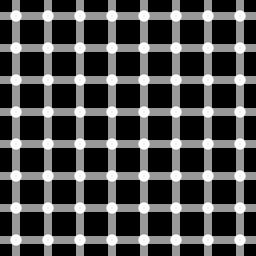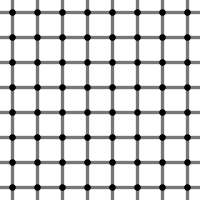Difference between revisions of "Grid illusion" - New World Encyclopedia
({{Contracted}}) |
|||
| Line 3: | Line 3: | ||
[[Category:Psychology]] | [[Category:Psychology]] | ||
| − | + | A '''grid illusion''' is any kind of [[grid]] that deceives a person's vision. The two most common types of grid illusions are '''Hermann grid illusions''' and '''Scintillating grid illusions'''. | |
| − | == | + | ==Discovery== |
| − | The '''Hermann grid illusion''' | + | The '''Hermann grid illusion''' was first reported by [[Ludimar Hermann]] in 1870, who discovered the illusion while reading [[John Tyndall]]'s ''On Sound''. In 1872, Ewald Hering observed that inverse colors (a black grid on a white background) produced similar results. Because of this, the Hermann grid is often referred to as the "Hermann-Hering" grid. |
| − | + | The '''scintillating grid illusion''' is an [[optical illusion]] discovered by Elke Lingelbach in 1994, and is usually considered a variation of the Hermann grid illusion. Lingelbach and colleagues published their findings in a 1995 article entitled "The Hermann grid and the scintillation effect" (Perception 24, supplement, page 89). | |
| − | |||
| − | The '''scintillating grid illusion''' is an [[optical illusion]] discovered by | ||
| − | + | ==Description== | |
| + | [[Image:Hermann grid illusion.svg|thumb|256px|right|A Hermann grid illusion. Shape position and color [[contrast (vision)|contrast]] converge to produce the illusion of gray blobs at the intersections.]] | ||
| + | The Hermann grid illusion is created with a grid of black squares upon a white background. "Ghostlike" gray figures are perceived at the intersections of a the white lines. These figures disappear when one looks directly at an intersection. | ||
| − | + | [[Image:Grid illusion.svg|thumb|256px|left|An example of the scintillating grid illusion. Dark dots seem to appear and disappear at intersections]] | |
| − | The | + | The scintillating grid illusion is similar in construction. Instead of white bars, however, there are grey bars with white discs inserted at each intersection. When a viewer moves their eyes around the image, black dots seem to appear and disappear. The illusion is enhanced by eye movement, and decreased by moving too close or too far away from the image. |
| + | [[Image:White grid illusion.svg|thumb|200px|right|A white-background version of the scintillating grid illusion.]] | ||
| − | + | ==Explanation== | |
| − | == | + | The effect of both optical illusions is commonly explained by a neural process called [[lateral inhibition]]. Retinal cells in the eye function as light receptors. If a single receptor is illuminated, a large amount of light is perceived. If neighboring receptors are also illuminated, the response in the main receptor diminishes. The illumination of receptors inhibits the firing of nearby receptors, and the effect is transmitted laterally. In the case of the Hermann grid illusion, the setup of the white bands creates a situation where there is more light surrounding the intersections than there is in between intersections. Thus the region by the intersection is more inhibited, and darker spots appear. The effect is greater in peripheral vision, since lateral inhibition works over greater distances peripherally.<ref>[http://psylux.psych.tu-dresden.de/i1/kaw/diverses%20Material/www.illusionworks.com/html/hermann_grid.html "Hermann Grid"] 1997. Illusion Works. Retrieved October 1, 2007.</ref> |
| − | The effect of both optical illusions is commonly | ||
| − | + | Scientists at MIT's Schiller Lab have disputed this widely accepted theory, proposing an alternate type of retinal functioning as an explanation for the illusion. Advocates of alternative theories argue that the Hermann grid effect is not size dependent, works equally well with contrast reversal, and that there are misconceptions in the function of retinal cells that are assumed by the lateral inhibition theory.<ref>http://web.mit.edu/bcs/schillerlab/research/A-Vision/A15-4.htm "The Neural Control of Vision"] MIT. Retrieved October 2, 2007.</ref> The alternate theory proposed is called the "S1 simple-cell theory", and suggests that the illusion results from reactions within the [[cortex]], not the retinal cells.<ref>http://web.mit.edu/bcs/schillerlab/research/A-Vision/A15-17.htm "The Neural Control of Vision"] MIT. Retrieved October 2, 2007.</ref> | |
| − | + | ==Applications== | |
| + | Both types of grid illusions, as well as related illusions, are excellent tools that help further the study of neuroscience. Scientists can use anomalies like perceptual illusions to try and discover exactly what processes are involved in both vision and perception. | ||
==Notes== | ==Notes== | ||
| + | <references /> | ||
| − | |||
==References== | ==References== | ||
| + | *Baars, Bernard and Nicole Gage. "Cognition, Brain, and Consciousness: Introduction to Cognitive Neuroscience" June 2007. Academic Press. ISBN 0123736773 | ||
| + | *Ninio, Jacques. "The Science of Illusions" April 2001. Cornell University Press. ISBN 0801437709 | ||
| + | *Seckel, Al. "Art of Optical Illusions" September 2000. Carlton Books. ISBN 1842220543 | ||
==External links== | ==External links== | ||
*[http://www.michaelbach.de/ot/lum_herGrid/index.html Refutation of classical explanation of Hermann Grid Illusion] | *[http://www.michaelbach.de/ot/lum_herGrid/index.html Refutation of classical explanation of Hermann Grid Illusion] | ||
| − | *[http://mathworld.wolfram.com/ScintillatingGridIllusion.html Scintillating Grid Illusion | + | *[http://mathworld.wolfram.com/ScintillatingGridIllusion.html Scintillating Grid Illusion - Mathworld] |
*[http://www.josef.org/scintillating.html Giant grid] | *[http://www.josef.org/scintillating.html Giant grid] | ||
| − | |||
| − | |||
{{Credits|Grid_illusion|149108681|}} | {{Credits|Grid_illusion|149108681|}} | ||
Revision as of 17:55, 2 October 2007
A grid illusion is any kind of grid that deceives a person's vision. The two most common types of grid illusions are Hermann grid illusions and Scintillating grid illusions.
Discovery
The Hermann grid illusion was first reported by Ludimar Hermann in 1870, who discovered the illusion while reading John Tyndall's On Sound. In 1872, Ewald Hering observed that inverse colors (a black grid on a white background) produced similar results. Because of this, the Hermann grid is often referred to as the "Hermann-Hering" grid.
The scintillating grid illusion is an optical illusion discovered by Elke Lingelbach in 1994, and is usually considered a variation of the Hermann grid illusion. Lingelbach and colleagues published their findings in a 1995 article entitled "The Hermann grid and the scintillation effect" (Perception 24, supplement, page 89).
Description
The Hermann grid illusion is created with a grid of black squares upon a white background. "Ghostlike" gray figures are perceived at the intersections of a the white lines. These figures disappear when one looks directly at an intersection.
The scintillating grid illusion is similar in construction. Instead of white bars, however, there are grey bars with white discs inserted at each intersection. When a viewer moves their eyes around the image, black dots seem to appear and disappear. The illusion is enhanced by eye movement, and decreased by moving too close or too far away from the image.
Explanation
The effect of both optical illusions is commonly explained by a neural process called lateral inhibition. Retinal cells in the eye function as light receptors. If a single receptor is illuminated, a large amount of light is perceived. If neighboring receptors are also illuminated, the response in the main receptor diminishes. The illumination of receptors inhibits the firing of nearby receptors, and the effect is transmitted laterally. In the case of the Hermann grid illusion, the setup of the white bands creates a situation where there is more light surrounding the intersections than there is in between intersections. Thus the region by the intersection is more inhibited, and darker spots appear. The effect is greater in peripheral vision, since lateral inhibition works over greater distances peripherally.[1]
Scientists at MIT's Schiller Lab have disputed this widely accepted theory, proposing an alternate type of retinal functioning as an explanation for the illusion. Advocates of alternative theories argue that the Hermann grid effect is not size dependent, works equally well with contrast reversal, and that there are misconceptions in the function of retinal cells that are assumed by the lateral inhibition theory.[2] The alternate theory proposed is called the "S1 simple-cell theory", and suggests that the illusion results from reactions within the cortex, not the retinal cells.[3]
Applications
Both types of grid illusions, as well as related illusions, are excellent tools that help further the study of neuroscience. Scientists can use anomalies like perceptual illusions to try and discover exactly what processes are involved in both vision and perception.
Notes
- ↑ "Hermann Grid" 1997. Illusion Works. Retrieved October 1, 2007.
- ↑ http://web.mit.edu/bcs/schillerlab/research/A-Vision/A15-4.htm "The Neural Control of Vision"] MIT. Retrieved October 2, 2007.
- ↑ http://web.mit.edu/bcs/schillerlab/research/A-Vision/A15-17.htm "The Neural Control of Vision"] MIT. Retrieved October 2, 2007.
ReferencesISBN links support NWE through referral fees
- Baars, Bernard and Nicole Gage. "Cognition, Brain, and Consciousness: Introduction to Cognitive Neuroscience" June 2007. Academic Press. ISBN 0123736773
- Ninio, Jacques. "The Science of Illusions" April 2001. Cornell University Press. ISBN 0801437709
- Seckel, Al. "Art of Optical Illusions" September 2000. Carlton Books. ISBN 1842220543
External links
- Refutation of classical explanation of Hermann Grid Illusion
- Scintillating Grid Illusion - Mathworld
- Giant grid
Credits
New World Encyclopedia writers and editors rewrote and completed the Wikipedia article in accordance with New World Encyclopedia standards. This article abides by terms of the Creative Commons CC-by-sa 3.0 License (CC-by-sa), which may be used and disseminated with proper attribution. Credit is due under the terms of this license that can reference both the New World Encyclopedia contributors and the selfless volunteer contributors of the Wikimedia Foundation. To cite this article click here for a list of acceptable citing formats.The history of earlier contributions by wikipedians is accessible to researchers here:
The history of this article since it was imported to New World Encyclopedia:
Note: Some restrictions may apply to use of individual images which are separately licensed.

